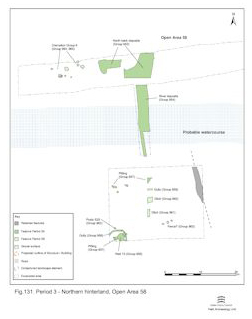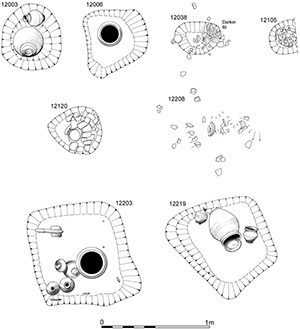
Cut into the Group 953 dump deposits along the north bank of the watercourse is a distinct group of eight (Group 964), or possibly nine (including Group 965), cremation burials (Figure 131). Not only notable for their tight clustering, they are also the only mid/later 2nd century features cut into the dumps, being sealed by further dump deposits of Period 4 date.
As a group, the eight definite cremation burials form a small, but clearly defined cluster. Consideration of the shapes of their cuts defines two trends; one square and generally deeper, the other round and shallow. The square cuts, 12203 and 12219, contain the more elaborate assemblages, most likely interred in boxes, while those in rounded cuts are relatively simple assemblages of one or two vessels placed directly in their pits (Figure 133).


The absence of burnt human remains in 12038, 12105, 12120 and 12208 does not preclude their being cremation burials. All are similar to the assemblages that do include such material. It is apparent that it is not obligatory to inter the complete remains of an individual in this rite of burial and it may well be the case that remains of the corpse are not strictly necessary at all.
The location of these burials, on the north side of the watercourse, may suggest adherence to Roman laws regarding burial, accepting that the watercourse itself presented something of a physical and symbolic boundary to the settlement, with land to its north being regarded as peripheral. However, a more recent investigation along Crescent Road (Roy 2003), on the upper terrace immediately north of these cemetery remains, has demonstrated the presence of settlement plots alongside (perhaps backing onto) the watercourse. Within one of these plots, a seemingly isolated later 2nd-century cremation burial was encountered.
The earliest ceramic grave goods accompanying these burials could in theory be as much as a century earlier than the latest. It is possible that this small group represents only a part of a larger, long-lived cemetery along the north bank. It is also possible that some of the pottery may have been curated and that antiques/heirlooms are used as grave goods. The stratigraphy (above the dumped bank deposits, which admittedly are not well dated but unlikely to be earlier than mid-2nd century, and below the more substantial rubble dumps of the early 3rd century), and the tight clustering of the group, suggest that a relatively short time-span is involved, and the earlier part of the second half of the 2nd century is the preferred date for these burials.
Further description of the artefactual content of these graves (including grave good assemblage illustrations) is presented elsewhere, while the significance of this cemetery in relation to the settlement is explored in Volume 1, Chapter 7.
Slightly oval cut, maximum of 0.6m wide and at least 0.2m deep. The cremation assemblage consists of a large greyware jar, containing cremated material (1880g), with an inverted samian dish used as a lid. A greyware flask lies to the north. This is the first of the cremation burials to be encountered; the jar protruded particularly high, although no cut could be discerned around it at the same level, and was disturbed during machine stripping of the trench.
A sub-square cut, approximately 0.6m across and 0.13m deep. It contains a centrally placed black-surfaced ware jar containing cremated remains (1125g) along with a folded red ware beaker. The jar is placed (?unusually) directly on top of a samian cup.
A small oval cut, maximum of 0.45m wide and 0.12m deep. The truncated cut and its immediate vicinity contains the disturbed remains of a greyware jar and a flask in black-surfaced ware. No cremated bone is apparent, though the flask is judged to be burnt.
A circular cut, 0.3m diameter and 0.14m deep. It contains a tall black-surfaced ware jar within which is another, inverted, smaller jar in the same fabric. Only 1g of cremated bone was retrieved.
A slightly oval cut, 0.48m wide and 0.1m deep. It contains a single, crushed, greyware jar, but no evidence of cremated material.
A square cut, approximately 0.9m wide and 0.27m deep. This has the largest and most diverse assemblage of grave goods, comprising a large greyware storage jar containing cremated material and six ancillary vessels to its west. The collection of ancillary vessels includes: a small Colchester colour-coated beaker on top of a samian dish; an inverted samian cup partially overlying the dish; a greyware flask and a Colchester buff-ware flagon in the south-west corner; a broken small green glass flask towards the north-west corner. A single green glass bead (SF7368) is recovered from the bulk soil sample collected from the backfill.
The burnt contents of the primary vessel include fourteen bone counters (SF6566) and seven unidentified fragmentary iron objects, along with a quantity of human bone (268g). Within the backfill of the cut, nails and other iron objects (SF4785, 4786, 4788), probably box-fittings, are located at the corners, demonstrating that the assemblage is interred within a wooden box. Perhaps outside this box, in the north-west corner of the grave, is an iron hanging lamp (SF4787, 5744, 6153, 6154) complete with its hanger. However, the presence of mineralised wood, from which planking can be discerned, may alternatively suggest that the lamp was included within the box.
A sub-square cut, a maximum of 0.9m wide and 0.3m deep. A large, centrally positioned, greyware storage jar, containing cremated remains (1155g), has probably fallen onto its side. A samian dish remains as placed in the mouth of the jar and is noted to have a rim-sherd missing. Two further small vessels, a fine greyware flask and a black-surfaced ware jar, lie to the east and west of the principal vessel. A complete clear glass cup is also included in the assemblage, though its precise location within the grave is not recorded. The remains of a melted green glass vessel, probably a vial, is also present in the backfill and is presumably an offering retrieved from the pyre debris.
Deposit 12208 is a discrete spread of pottery recorded over an area of 0.9m by 0.4m. It apparently overlies dump deposit 12037 and no cut is discerned. This 2nd-century material comprises a miniature vessel and the majority of a jar, which may indicate that it derived from a cremation burial, perhaps disturbed during further dumping in Period 4. No cremated material is identified in association.
Internet Archaeology is an open access journal based in the Department of Archaeology, University of York. Except where otherwise noted, content from this work may be used under the terms of the Creative Commons Attribution 3.0 (CC BY) Unported licence, which permits unrestricted use, distribution, and reproduction in any medium, provided that attribution to the author(s), the title of the work, the Internet Archaeology journal and the relevant URL/DOI are given.
Terms and Conditions | Legal Statements | Privacy Policy | Cookies Policy | Citing Internet Archaeology
Internet Archaeology content is preserved for the long term with the Archaeology Data Service. Help sustain and support open access publication by donating to our Open Access Archaeology Fund.